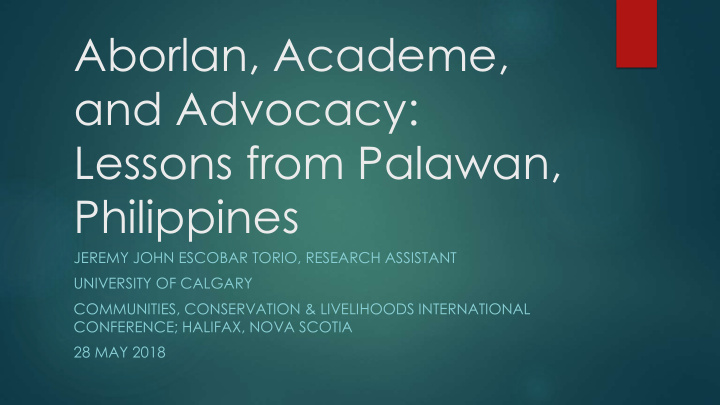



Aborlan, Academe, and Advocacy: Lessons from Palawan, Philippines JEREMY JOHN ESCOBAR TORIO, RESEARCH ASSISTANT UNIVERSITY OF CALGARY COMMUNITIES, CONSERVATION & LIVELIHOODS INTERNATIONAL CONFERENCE; HALIFAX, NOVA SCOTIA 28 MAY 2018
Climate Communication and Adaptation Research in the Philippines Comparative work with the island nation of Indonesia Research work had three underlying topics: Climate change: 1. What is climate change? Climate change communication: 2. How is climate change disseminated and communicated among diverse actors in the community? Participation in environmental decision-making: 3. How do actors participate in decision-making related to natural resources management, development, and policy?
Palawan, Philippines “Last ecological frontier” Agrarian lands, fishing grounds, and geologic rock formations Farming, fishing, and tourism
Aborlan Situated approximately 90 km south of Puerto Princesa Population of approximately 35,000 people in 2015 Sparse communities throughout the municipality Poor community reliant mainly on farming and fishing Why Aborlan? Conservation work in regards to mangrove forests, the expansion of marine protected areas, and ecotourism
Academe: Western Philippines University (WPU) Founded in 1910 Began as an agricultural college Expanded to include subjects in business, education, engineering, marine sciences, and social sciences
Climate Change to Coal Climate change caused by anthropogenic acts: Garbage Plastics Smoke Coal-powered plant Narra: located directly in front of the Rasa Wildlife Sanctuary that contains the country’s last remaining coastal forests Aborlan: situated across a fish sanctuary where locals rely primarily on the fishing grounds for their livelihoods
Advocacy from the Academy Information, Education, Communication (IEC) campaigns Focused mainly on health-related risks stemming from coal-powered plants Flyer distribution in town Workshops and seminars Emphasis on fishing grounds, farm lands, and livelihoods Personal narratives about health challenges (e.g. asthma and issues of clean drinking water) Social media
Challenges on the Ground Participation Distance to workshops and seminars Scientific jargon Seminars and workshop times Funding Invited spaces Communication Dependent mainly on community ‘gossip’ Environmental activism in social media is still an underdeveloped phenomenon among the poor
Challenges on the Ground Academics as activists Research work and meetings Environmental activism dependent on conservation or livelihood threats Environmental education applied concurrently with environmental activism rather than an ongoing process Community activism Threats from corporate representatives Corruption Sentiments of
Implications Hierarchy of power and politics among the poor Deliberative democracy Participatory activism Gradual growth of information and communication technology Social media Ecological citizenship
THANK YOU! JEREMY JOHN ESCOBAR TORIO, RESEARCH ASSISTANT UNIVERSITY OF CALGARY JJTORIO@UCALGARY.CA
Recommend
More recommend